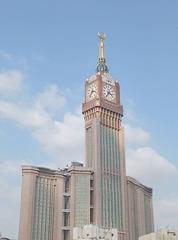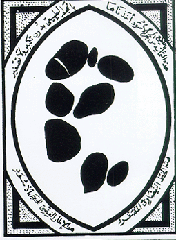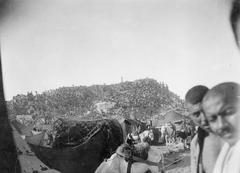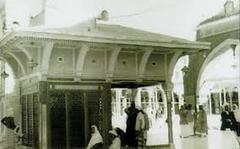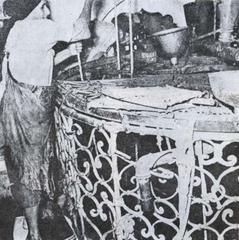Al-Zaher Palace Museum: Visiting Hours, Tickets, and a Guide to Mecca’s Premier Historical Site
Date: 14/06/2025
Introduction
Al-Zaher Palace Museum, also known as the Makkah Museum, stands in the heart of Mecca as a remarkable emblem of Islamic heritage and Saudi Arabia’s dedication to preserving its cultural legacy. Originally constructed in the early 20th century as a royal residence, the palace reflects the grandeur of traditional Islamic architecture, with its intricate geometric motifs, expansive courtyards, and lush gardens designed for spiritual reflection. Its transformation into a museum marked a pivotal moment in showcasing Mecca’s evolution from ancient times to the present day. Today, the museum houses over 100,000 artifacts, including manuscripts, coins, ceramics, and religious relics, tracing the city’s journey through the ages and offering a unique educational experience to pilgrims and tourists alike.
Conveniently located just 10–20 minutes by car from the Grand Mosque, Al-Zaher Palace Museum is easily accessible and complements the spiritual journey of visitors with an immersive cultural encounter. This detailed guide covers everything you need to know: visiting hours, ticketing, accessibility, highlights of the collections, travel tips, and how to make the most of your visit to this essential Mecca landmark (destinationksa.com, Elaf Hotels, 3rooj.com).
Table of Contents
- Origins of Al-Zaher Palace
- Palace Transformation and Restoration
- Architectural Features and Enhancements
- Visiting Hours, Tickets, and Accessibility
- Historical Collections and Exhibitions
- Museum’s Role in Islamic Heritage Preservation
- Visitor Experience: Facilities, Layout, and Tips
- Frequently Asked Questions (FAQ)
- Plan Your Visit: Travel Tips and Nearby Attractions
- References and Official Links
Origins of Al-Zaher Palace
Al-Zaher Palace was constructed in the early 20th century as a royal residence during a time of significant transformation in the Arabian Peninsula. The palace’s design is rooted in the Islamic architectural tradition, characterized by its symmetrical layout, arched windows, and geometric motifs. Expansive courtyards and lush gardens create a sense of tranquility, while the use of local materials and skilled craftsmanship highlights the region’s artistic heritage. Its prominent location in Mecca, Islam’s holiest city, made it a symbol of authority and religious reverence (destinationksa.com).
Transformation into the Makkah Museum
Conversion and Restoration
Recognizing the palace’s historical and architectural value, Saudi authorities initiated a careful restoration and adaptive reuse project to convert it into the Makkah Museum. The process involved preserving original features—such as ornate facades, carved wooden doors, decorative ceilings, and marble floors—while adding modern amenities for visitor comfort, including climate control and accessibility features. The gardens and tranquil ponds enhance the site’s contemplative atmosphere (destinationksa.com).
Cultural Institution
Upon its inauguration as a museum, Al-Zaher Palace became a repository of Mecca’s history and Islamic heritage. Its mission is to document, preserve, and present the story of Mecca and the broader Islamic world through curated exhibitions, educational programs, and public events. Spacious halls and galleries provide an ideal setting for the museum’s diverse collections (destinationksa.com).
Architectural Features and Modern Enhancements
- Islamic Architectural Heritage: The palace’s two-story structure features symmetrical design, arched windows, mosaic tiles, and lush gardens with water features symbolizing paradise in Islamic culture.
- Modern Enhancements: The museum seamlessly integrates technology—interactive exhibits, multimedia presentations, and climate-controlled galleries. Amenities include a café, gift shop, library, and pure Zamzam water stations. Separate prayer areas and gender-specific facilities ensure comfort and respect for religious practices (Elaf Hotels).
Visiting Hours, Tickets, and Accessibility
- Visiting Hours: Most commonly, Saturday to Thursday, 9:00 AM – 4:00 or 5:00 PM. Closed on Fridays and some public holidays (Almosafer), (3rooj.com), (Zamzam.com). Some sources report split sessions; always confirm via the official website before visiting.
- Tickets: Admission is generally free; special exhibitions may require tickets. Guided tours are available (often for a nominal fee) and can be reserved in advance.
- Accessibility: The museum is equipped with ramps, elevators, and accessible restrooms. Wheelchairs are available on request. Multilingual guides and audio tours cater to international visitors.
- Facilities: Prayer rooms, restrooms, a café, gift shop, library, and auditorium are available for guest comfort.
Historical Collections and Exhibitions
Overview
The museum’s collections feature over 100,000 artifacts, offering a chronological journey through Mecca’s history and Islamic civilization (Elaf Hotels), (destinationksa.com).
Key Exhibition Themes
- Pre-Islamic Mecca: Archaeological finds, including stone tools, South Arabian and Thamudic inscriptions, and pottery shards, trace Mecca’s early role as a trading hub.
- Prophet’s Era and Islamic Rise: Replicas of the Kaaba, early Qur’anic manuscripts, and artifacts linked to the Prophet Muhammad and his companions.
- Islamic Art and Calligraphy: Exquisite Qur’anic manuscripts, mosque tiles, Islamic coins, and seals.
- Two Holy Mosques Exhibition: Scale models, photographs, and architectural elements from Masjid al-Haram and Masjid an-Nabawi (Makkah Museum - Exhibition Of The Two Holy Mosques).
- Meccan Social and Cultural Life: Traditional clothing, household items, photographs, and oral histories.
- The Hajj Experience: Historical permits, pilgrimage route models, and ritual artifacts.
Notable Artifacts
- Rare 18th-century Kiswah embroidered with gold and silver.
- Qur’anic manuscripts from the Umayyad and Abbasid periods.
- Architectural fragments from Masjid al-Haram.
- Personal items of Islamic scholars and leaders.
Special Programs
Regular temporary exhibitions, educational workshops, and cultural events coincide with religious and national holidays. The museum’s theater hosts multimedia shows, including programs on the 99 names of Allah (Rehlat).
Museum’s Role in Islamic Heritage Preservation
The transformation of Al-Zaher Palace into a museum underscores Saudi Arabia’s commitment to preserving and promoting Islamic heritage. The museum is a key resource for students, researchers, and visitors, fostering deeper understanding of Mecca’s historical and spiritual significance. Its outreach includes support for academic research, international visitors, and interfaith understanding (destinationksa.com).
Visitor Experience: Facilities, Layout, and Tips
- Layout: The museum comprises multiple galleries arranged around a central courtyard, with thematic sections for archeology, manuscripts, art, and the history of pilgrimage.
- Amenities: Prayer halls for men and women, restrooms, café, gift shop, library, and auditorium.
- Duration: 1.5–2.5 hours is recommended for a complete tour.
- Guided Tours: Available in Arabic and English; book in advance for group visits.
- Photography: Allowed in most areas; flash and tripods may be restricted. Some exhibits prohibit photography.
- Dress Code: Modest attire required—men should wear long trousers and sleeved shirts; women an abaya and head covering.
- Best Time to Visit: Mornings and weekdays outside Hajj and Umrah seasons are less crowded (Saudi Private Tours).
Frequently Asked Questions (FAQ)
Q: What are the visiting hours?
A: Saturday to Thursday, 9:00 AM – 4:00/5:00 PM. Closed on Fridays and some holidays.
Q: Is there an entrance fee?
A: General admission is free; special exhibits or tours may have a fee.
Q: Are guided tours available?
A: Yes, in Arabic and English. Advance booking is recommended for groups.
Q: Is the museum wheelchair accessible?
A: Yes, with ramps, elevators, and accessible restrooms.
Q: Can non-Muslims visit?
A: Yes, all visitors are welcome.
Q: Is photography allowed?
A: Yes, except for certain exhibits; no flash or tripods.
Plan Your Visit: Travel Tips and Nearby Attractions
- Getting There: Located on Makkah Al Madinah Munawwarah Road, 4–6 km north of Masjid al-Haram. Best reached by taxi or ride-hailing services.
- Nearby Sites: Combine your visit with the Grand Mosque, Ajyad Fortress, Jannat al-Mu’alla cemetery, Souq Al-Khalil, and the Makkah Clock Tower Museum.
- Contact: +966 12 547 1815 (The Haramaynguide), official website.
- Amenities: On-site parking, café, gift shop, and prayer facilities.
For up-to-date information, check the official website and social media channels before your visit.
References and Official Links
- Destination KSA – Makkah Museum Overview
- Elaf Hotels – Mecca Museum at Al-Zaher Palace
- Genspark AI – Mecca Museum
- Almosafer – Museums in Makkah
- 3rooj.com – Makkah Museum
- Zamzam.com – Museums in Makkah
- Trek Zone – Al-Zaher Palace Museum
- The Haramaynguide – Museums in Makkah
- Saudi Private Tours – Best Museums
Final Tips
Al-Zaher Palace Museum is more than a historical building—it’s a vibrant cultural institution bridging Mecca’s illustrious past and present. Its restoration and adaptive reuse highlight Saudi Arabia’s commitment to Islamic heritage, while its inclusive facilities and engaging exhibitions provide profound insights for all. Plan ahead for your visit, use the Audiala app for interactive guides, and follow the museum’s channels for the latest updates. Immerse yourself in the spiritual and cultural richness that only Al-Zaher Palace Museum offers (destinationksa.com, Elaf Hotels, 3rooj.com).
